native americans
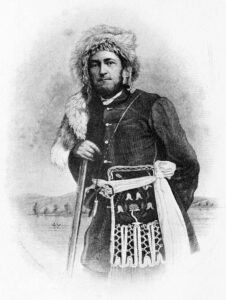 Joe Meek was born in Virginia in 1810. He was a friendly young man, with a great sense of humor, but he had too much rambunctious energy to do well in school. He just couldn’t sit still well enough to focus on his studies. Finally, at 16 years old and illiterate, Meek gave up on school and moved west to join two of his brothers in Missouri. Still, he didn’t give up on all of his learning, just the formal learning. In later years, he taught himself to read and write, but his spelling and grammar remained “highly original” throughout his life.
Joe Meek was born in Virginia in 1810. He was a friendly young man, with a great sense of humor, but he had too much rambunctious energy to do well in school. He just couldn’t sit still well enough to focus on his studies. Finally, at 16 years old and illiterate, Meek gave up on school and moved west to join two of his brothers in Missouri. Still, he didn’t give up on all of his learning, just the formal learning. In later years, he taught himself to read and write, but his spelling and grammar remained “highly original” throughout his life.
Meek seemed to flourish in the West. It appears that he had found his calling, and in early 1829, he joined William Sublette’s ambitious expedition to begin fur trading in the Far West. Meek traveled throughout the West for the next decade. For him there was nothing greater than the adventure and independence of the mountain man life. Meek, the picture of a mountain man, at 6 feet 2 inches tall, and heavily bearded became a favorite character at the annual mountain-men rendezvous. The others loved to listen to his humorous and often exaggerated stories of his wilderness adventures. The truth is, I’m sure many people would have loved to hear about the adventures of the mountain man, especially this one, who was so unique. Like most mountain men, Meek was a renowned grizzly bear hunter. I suppose his stories of his hunting escapades could have been exaggerations, it’s hard to say. Meek claimed he liked to “count coup” on the dangerous animals before killing them, a variation on a Native American practice in which they shamed a live human enemy by tapping them with a long stick. To tap a grizzly bear with a stick, before the attempted kill, took either courage…or stupidity. Meek also claimed that he had wrestled an attacking grizzly with his bare hands before finally sinking a tomahawk into its brain. I suppose that if a grizzly bear attacked you, you would have no choice but to fight for your life, with your bare hands. Having the forethought to go for your tomahawk would be…well, amazing. Most people would try to cover their heads, and hope for the best. Still, that wouldn’t do much good. In a bear attack, you had better fight with everything you have, if you want to live. Maybe 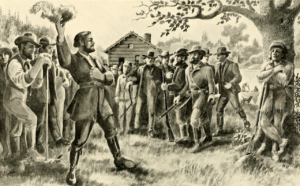 mountain men spent a lot of time considering the possibility of an attack, and practicing in their head exactly how they would handle it.
mountain men spent a lot of time considering the possibility of an attack, and practicing in their head exactly how they would handle it.
Meek soon established good relations with many Native Americans, effectively melding with the Indians. He even married three Native American women, including the daughter of a Nez Perce chief. Now, that didn’t mean that he didn’t fight with the tribes on occasion, or at least the tribes who were hostile to the incursion of the mountain men into their territories. Meek intended to fight for his right to be on the land, the same as the Indians. In the spring of 1837, Meek was nearly killed by a Blackfeet warrior who was taking aim with his bow while Meek tried to reload his Hawken rifle. In the end, the warrior nervously dropped his first arrow while drawing the bow, and Meek had time to reload and shoot. The warrior’s fumble cost him his life, while saving Meek’s life.
After a great run as a mountain man, Meek recognized that the golden era of the free trappers was coming to a close. He began making plans to find another form of income. He joined with another mountain man, and along with his third wife, he guided one of the first wagon trains to cross the Rockies on the Oregon Trail. Once he arrived in Oregon, Meek fell in love with the lush Willamette Valley of western Oregon. He settled down and became a farmer, and actively encouraged other Americans to join him. Of course, more White men on what had been Indian lands, came with safety issued. Meek led a delegation to Washington DC to ask for military protection from Native American attacks and territorial status for Oregon in 1847. Though he arrived “ragged, 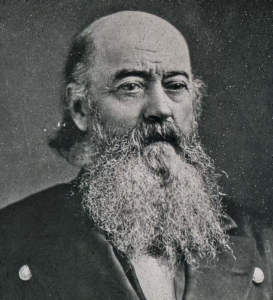 dirty, and lousy,” Meek became a bit of a celebrity in the capitol. Not used to the ways of mountain men, the Easterners truly enjoyed the rowdy good humor Meek showed in proclaiming himself the “envoy extraordinary and minister plenipotentiary from the Republic of Oregon to the Court of the United States.” His enthusiasm prompted Congress to making Oregon an official American territory and Meek a US marshal. I wonder if he was shocked by his new role.
dirty, and lousy,” Meek became a bit of a celebrity in the capitol. Not used to the ways of mountain men, the Easterners truly enjoyed the rowdy good humor Meek showed in proclaiming himself the “envoy extraordinary and minister plenipotentiary from the Republic of Oregon to the Court of the United States.” His enthusiasm prompted Congress to making Oregon an official American territory and Meek a US marshal. I wonder if he was shocked by his new role.
He might have been shocked, but Meek embraced his new role. He returned to Oregon and became heavily involved in politics, eventually founded the Oregon Republican Party. After his years of service, he retired to his farm, and on June 20, 1875, at the age of 65, Meek passed away. With his passing the world lost a skilled practitioner of the frontier art of the tall tale. It is said that his life was nearly as adventurous as his stories claimed, but there is no sure line to tell what was real and what was tall tale.
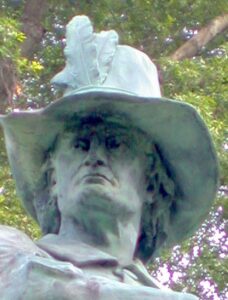 Captain John Mason was an English-born settler, soldier, commander, and Deputy Governor of the Connecticut Colony. While most people want to be remembered for the great things they did during their lives, Captain Mason will always be remembered for something else…being the leader of the massacre of the Pequot Tribe of Native Americans in southeast Connecticut. The group, led by Mason was a group of Puritan settlers and Indian allies, who combined to attack a Pequot Fort in an event known as the Mystic Massacre. The Mystic Massacre took place on May 26, 1637, during the Pequot War, when Connecticut colonizers and their Narragansett and Mohegan allies set fire to the Pequot Fort near the Mystic River. With the fire raging, they shot anyone who tried to escape the wooden palisade fortress, effectively murdering most of the village. In all, there were between 400 and 700 Pequot civilians killed during the massacre. The only Pequot survivors were warriors who were away in a raiding party with their sachem (chief), Sassacus.
Captain John Mason was an English-born settler, soldier, commander, and Deputy Governor of the Connecticut Colony. While most people want to be remembered for the great things they did during their lives, Captain Mason will always be remembered for something else…being the leader of the massacre of the Pequot Tribe of Native Americans in southeast Connecticut. The group, led by Mason was a group of Puritan settlers and Indian allies, who combined to attack a Pequot Fort in an event known as the Mystic Massacre. The Mystic Massacre took place on May 26, 1637, during the Pequot War, when Connecticut colonizers and their Narragansett and Mohegan allies set fire to the Pequot Fort near the Mystic River. With the fire raging, they shot anyone who tried to escape the wooden palisade fortress, effectively murdering most of the village. In all, there were between 400 and 700 Pequot civilians killed during the massacre. The only Pequot survivors were warriors who were away in a raiding party with their sachem (chief), Sassacus.
Prior to the massacre, the Pequot tribe were the dominate Native American tribe in southeast Connecticut, but  with the massacre, came the end of an era where that was concerned. The massacre was brutal and heinous and should have been met with severe punishment, but at that time in history, the Native Americans were not particularly valued among the people of the colonies. In fact, the Native Americans were probably viewed as the intruders, and not the natives. As more and more Puritans from Massachusetts Bay spread into Connecticut, the conflicts with the Pequots increased. The tribe centered on the Thames River in southeastern Connecticut, and by the spring of 1637, the Pequot tribe killed 13 English colonists and traders. That was when Massachusetts Bay Governor John Endecott organized a large military force to punish the Indians, who were only trying to protect what they saw as theirs. On April 23, 1637, with pressure mounting, 200 Pequot warriors responded defiantly to the colonial mobilization by attacking a Connecticut settlement, killing six men and three women and taking two girls away.
with the massacre, came the end of an era where that was concerned. The massacre was brutal and heinous and should have been met with severe punishment, but at that time in history, the Native Americans were not particularly valued among the people of the colonies. In fact, the Native Americans were probably viewed as the intruders, and not the natives. As more and more Puritans from Massachusetts Bay spread into Connecticut, the conflicts with the Pequots increased. The tribe centered on the Thames River in southeastern Connecticut, and by the spring of 1637, the Pequot tribe killed 13 English colonists and traders. That was when Massachusetts Bay Governor John Endecott organized a large military force to punish the Indians, who were only trying to protect what they saw as theirs. On April 23, 1637, with pressure mounting, 200 Pequot warriors responded defiantly to the colonial mobilization by attacking a Connecticut settlement, killing six men and three women and taking two girls away.
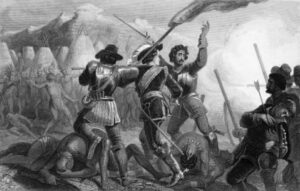 Then on May 26, 1637, everything exploded when, two hours before dawn, the Puritans and their Indian allies marched on the Pequot village at Mystic, slaughtering all but a handful of its inhabitants. Following that attack, Captain Mason attacked another Pequot village on June 5, 1637, this one near what is now Stonington, and again the Indian defenseless inhabitants, were defeated and massacred. In a third attack on July 28, 1637, Mason and his men massacred a village near what is now Fairfield, and the Pequot War finally came to an end. Most of the surviving Pequot were sold into slavery, though a handful escaped to join other southern New England tribes.
Then on May 26, 1637, everything exploded when, two hours before dawn, the Puritans and their Indian allies marched on the Pequot village at Mystic, slaughtering all but a handful of its inhabitants. Following that attack, Captain Mason attacked another Pequot village on June 5, 1637, this one near what is now Stonington, and again the Indian defenseless inhabitants, were defeated and massacred. In a third attack on July 28, 1637, Mason and his men massacred a village near what is now Fairfield, and the Pequot War finally came to an end. Most of the surviving Pequot were sold into slavery, though a handful escaped to join other southern New England tribes.
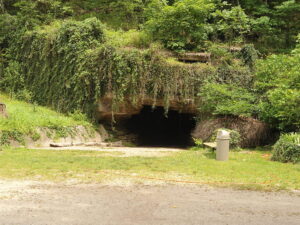 Every time I hear about a lost treasure, I wonder how many such treasures there are around the world. Some of these treasures are most likely lost forever, and one of those (so far anyway) is “The Old Spanish Treasure” which isn’t a treasure in a tropical, mysterious location from a long-ago shipwreck. Legend has it that the treasure is located in “The Old Spanish Treasure Cave,” which is actually located along the Missouri-Arkansas border. The location in and of itself, makes me wonder why no one has ever recovered the treasure.
Every time I hear about a lost treasure, I wonder how many such treasures there are around the world. Some of these treasures are most likely lost forever, and one of those (so far anyway) is “The Old Spanish Treasure” which isn’t a treasure in a tropical, mysterious location from a long-ago shipwreck. Legend has it that the treasure is located in “The Old Spanish Treasure Cave,” which is actually located along the Missouri-Arkansas border. The location in and of itself, makes me wonder why no one has ever recovered the treasure.
Apparently, about 400 years ago, Spanish conquistadors headed north in the dead of winter, raiding Native American villages as they went. During the raids, they accumulated a great amount of treasure, but the winter was raging, and they needed a place to get out of the cold. So, the conquistadors took refuge in a large cave. Of 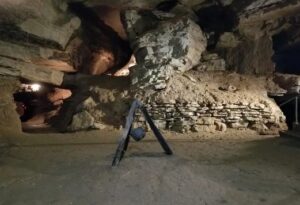 course, they thought they were alone, but that couldn’t have been further from the truth. The Native Americans saw their campfire smoke coming out of a natural chimney at the top of the cave. Taking their revenge, the Native Americans attacked the conquistadors, leaving only one survivor.
course, they thought they were alone, but that couldn’t have been further from the truth. The Native Americans saw their campfire smoke coming out of a natural chimney at the top of the cave. Taking their revenge, the Native Americans attacked the conquistadors, leaving only one survivor.
Somehow keeping his wits about him, the survivor sealed all but one entrance and drew two maps…one on parchment, and one etched into a limestone rock. While the rock bearing the map was recovered, the treasure has yet to be found. The location of the cave is known, and I’m sure it and the map have been scoured repeatedly, but the survivor hid his treasure well. It almost makes me wonder if he hid it at all. Maybe he just took it with him or went back for it soon after it was hidden, and then simply left the map to throw people off the trail.
 The cave was sealed up until it was re-discovered in 1885 by an old Spaniard from Madrid. As the story goes, old Spaniard the legend apparently led him to two maps…one on a tree, and another on a rock. Neither these maps nor the treasure, estimated today at 40 million dollars, have ever been found, but there have been a number of artifacts found, like helmets, pieces of armor, and weapons from the period. Some have even claimed to have found a few gold coins, but there is no proof of that. The Spaniard was ill, and so did not stay long. Other people continued to search for the treasure for many years, but to no avail. To this day, the elusive treasure remains hidden, and I suppose it always will.
The cave was sealed up until it was re-discovered in 1885 by an old Spaniard from Madrid. As the story goes, old Spaniard the legend apparently led him to two maps…one on a tree, and another on a rock. Neither these maps nor the treasure, estimated today at 40 million dollars, have ever been found, but there have been a number of artifacts found, like helmets, pieces of armor, and weapons from the period. Some have even claimed to have found a few gold coins, but there is no proof of that. The Spaniard was ill, and so did not stay long. Other people continued to search for the treasure for many years, but to no avail. To this day, the elusive treasure remains hidden, and I suppose it always will.

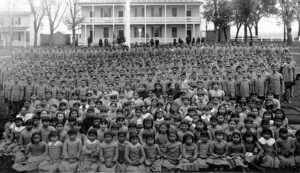 When people allow fear to enter into their thinking, unfortunate and sometimes horrific things can happen. That really was the case, I believe, with the American settlers and the Native Americans. I’m not saying that the treatment of the Indians was without blame, because that is just not the case, but the wars that took place left the American settlers afraid of the Indians, and some people even decided that we needed to basically, “teach it out of them” or change the way the children thought so we could change a generation. It sounds a lot like what is being attempted in our schools today, if you ask me.
When people allow fear to enter into their thinking, unfortunate and sometimes horrific things can happen. That really was the case, I believe, with the American settlers and the Native Americans. I’m not saying that the treatment of the Indians was without blame, because that is just not the case, but the wars that took place left the American settlers afraid of the Indians, and some people even decided that we needed to basically, “teach it out of them” or change the way the children thought so we could change a generation. It sounds a lot like what is being attempted in our schools today, if you ask me.
For over a century, the US government actually went in and took Native American children from their families and forced them to attend Indian boarding schools. The idea was to separate the Indian traditions, language, and culture from these children, so they would become a “man worth saving,” because they thought the Indians had no value. They even recruited the missionaries in their endeavor, with the passing of the Civilization Fund Act of 1819, which encouraged missionaries to educate Native American children in the ways of the white man. In reality, this plan set the stage for eventual forced removal of children from their parents, so the parents could no longer have a say in their education, or an influence in their lives. In 1879, Captain Richard Henry Pratt opened the Carlisle Indian Industrial School. The whole purpose of the school, according to Pratt, was to “kill the Indian, and save the man.”
The schools mistreated the children, because they didn’t want to comply, didn’t understand what was asked of them, or they were just plain scared. Scholar Margaret Archuleta explained, “Not only were children removed from their parents, often forcibly, but they had their mouths washed out with lye soap when they spoke their Native languages.” A 1902 government order even argued long hair and other traditional customs slowed “the advancement they are making in civilization.” These poor children were stripped of their heritage, their families, their traditions, and their right to live a free life of their own choosing.
You might think that this barbaric act was something that was practiced just in the early days of this country and into the Indian Wars era, but these boarding schools actually continued until 1978!! At that time, Congress 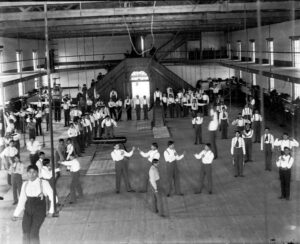
 finally passed the Indian Child Welfare Act, which also addressed the practice of forcible adoption of Native American children. From that time on, Native American families were once again able to practice their own traditions and culture and speak their own language. I wonder just how much of their heritage was lost forever in the 159 years that the children spent in the custody of the American government.
finally passed the Indian Child Welfare Act, which also addressed the practice of forcible adoption of Native American children. From that time on, Native American families were once again able to practice their own traditions and culture and speak their own language. I wonder just how much of their heritage was lost forever in the 159 years that the children spent in the custody of the American government.

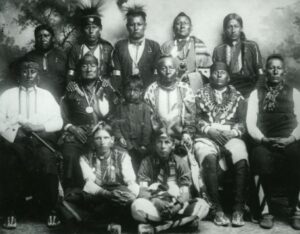 During the years when America was expanding very quickly, many Native American nations were placed on reservations, and the land they had previously lived on was taken from them…often by force, but sometimes by choice. Some Indians saw the writing on the wall and chose to go to the reservation so their people could survive. Those who didn’t found themselves in multiple battles that often ended in death.
During the years when America was expanding very quickly, many Native American nations were placed on reservations, and the land they had previously lived on was taken from them…often by force, but sometimes by choice. Some Indians saw the writing on the wall and chose to go to the reservation so their people could survive. Those who didn’t found themselves in multiple battles that often ended in death.
One group, the Osage Tribe made the decision to abandon their lands in Missouri and Aransas, giving it to the White Man’s Government, in exchange for the reservation in Oklahoma that was offered to them. I’m sure there were those within the tribe who were not happy with the decision that was made, but time would prove that it was the wisest decision to make. The decision made at that time, would later make them one of the wealthiest surviving Native American nations. The Osage Tribe was, at one time, the largest tribe of the Southern Sioux people. They occupied what are now the states of Missouri, Kansas, and Nebraska. This sophisticated tribe of people surprised the first Anglo explorers and settlers. When the settlers moved into the region, they found this Native American tribe living in more or less permanent villages made of sturdy earthen and log lodges. They really didn’t expect these people, whom they considered to be primitive, to be in such modern-day (for the times anyway) homes. The Osage Tribe is related to the Quapaw, Ponca, Omaha, and Kansa peoples. Like their cousins the Plains Indians, the Osage Tribe hunted buffalo and wild game, but they also raised crops to supplement their diets. They were really forward thinking, which was unusual for the times.
Americans found it much easier to understand and negotiate with the Southern Sioux, even though they often warred among themselves. They felt like they could understand the Southern Sioux much easier, because of their more sedentary ways…thing that the more nomadic Northern Sioux just didn’t make sense in that they just seemed to wander around. The White Man didn’t understand that kind of thinking. Maybe it was the more permanent homes offered by the American negotiators, that convinced the Osage Tribe to abandon their traditional lands and move peacefully to a reservation in southern Kansas in 1810. Unfortunately, that would not be the move that made the White Man happy, so when American settlers began to covet the Osage reservation in Kansas, the tribe agreed to yet another move, relocating to what is now Osage County, Oklahoma, in 1872.
While the American settlers found it easier to work with the Osage Tribe and the Southern Sioux, they were not always truly fair with them. The American settlers constantly pressured the government to push Native Americans off valuable lands and onto marginal reservations. Unfortunately, this practice was all too common throughout the history of western settlement. Most tribes were devastated by these relocations, including some of the Southern Sioux tribes like the Kansa, whose population of 1,700 was reduced to only 194 following their disastrous relocation to a 250,000-acre reservation in Kansas. Nevertheless, the Osage tribe, proved unusually 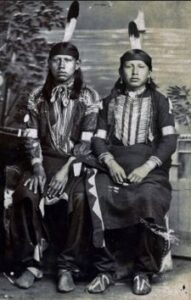
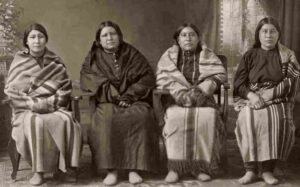 successful in adapting to the demands of living in a world dominated by Anglo-Americans. Of course, a big part of their success and wealth is due in part to the presence of large reserves of oil and gas on their Oklahoma reservation, as well as the effective management of the grazing contracts set up with the Anglos. During the twentieth century, the Osage amassed enormous wealth from their oil and gas deposits, eventually becoming the wealthiest tribe in North America.
successful in adapting to the demands of living in a world dominated by Anglo-Americans. Of course, a big part of their success and wealth is due in part to the presence of large reserves of oil and gas on their Oklahoma reservation, as well as the effective management of the grazing contracts set up with the Anglos. During the twentieth century, the Osage amassed enormous wealth from their oil and gas deposits, eventually becoming the wealthiest tribe in North America.
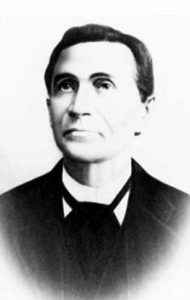 The other day, while reading an article about notable Native Americans, I came across a name that was familiar to me, but really didn’t seem like a Native American name. The name was Renville, the same name as my grand-nephew, James Renville. Immediately, I wondered if there might be a connection between Chief Gabriel Renville and my grand-nephew. The search didn’t take very long, before I had my answer. Gabriel Renville is my grand-nephew, James’ 1st cousin 7 times removed. I find that to be extremely amazing to think that James is related to an Indian chief. With that information, I wanted to fine out more abut this man.
The other day, while reading an article about notable Native Americans, I came across a name that was familiar to me, but really didn’t seem like a Native American name. The name was Renville, the same name as my grand-nephew, James Renville. Immediately, I wondered if there might be a connection between Chief Gabriel Renville and my grand-nephew. The search didn’t take very long, before I had my answer. Gabriel Renville is my grand-nephew, James’ 1st cousin 7 times removed. I find that to be extremely amazing to think that James is related to an Indian chief. With that information, I wanted to fine out more abut this man.
Chief Gabriel Renville was a mixed-blood Santee Sioux—his father was half French and his mother half-Scottish. He was born in April of 1825 at Big Stone Lake, South Dakota. Renville was the treaty chief of the Sisseton-Wahpeton Santee tribes and signed the 1867 treaty, which established the boundaries of the Lake Traverse Reservation. One source called him a Champion of Excellence.
He was careful to protect his people as much as he could, and was also instrumental in saving the lives of many white captives. During the 1862 Uprising, Renville opposed Little Crow and was influential in keeping many of the Santee out of the war. He lost a large amount of property, including horses appropriated by the hostile savages, or destroyed in consequence of his position to their murderous course. Renville served as chief of scouts for General Sibley during the campaign against the Sioux in 1863.
Even though Chief Renville was an ally of the whites, it didn’t help him when he settled on the reservation. The government agent there, Moses N. Adams, considered him hostile. Renville was the leader of the “scout party” which was in conflict with the “good church” Indians. I’m sure that was common in those days. Renville preserved many of the traditional Santee customs of polygamy and dancing, and he ignored Christianity, but he 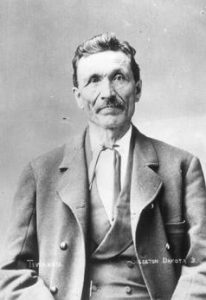 was not opposed to economic progress and he and his followers became successful farmers on the reservation. However, the Sisseton agent favored the “church” Indians.
was not opposed to economic progress and he and his followers became successful farmers on the reservation. However, the Sisseton agent favored the “church” Indians.
Renville and other leaders of the traditional Indians accused Adams of discriminating against them in the disposition of supplies and equipment. He said Adams favored the idle church-goers instead of encouraging them to work….a situation not unlike the current welfare system. Agent Adams considered Renville a detriment and removed the chief form the reservation executive board which Adams had organized to carry out his policies. It was a move that was considered extreme. In 1874 Renville was finally successful in securing a government investigation of the Adam’s activities. The outcome of the investigation was an official censure of Adams. Chief Renville continued to practice the old Santee customs, yet he encouraged the Indians to farm. This progressive influence was greatly missed after his death in August 1892.
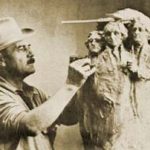
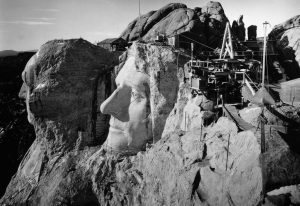 When a construction project begins, it usually takes a matter of a few months to complete. That is not how it works when carving a large sculpture, such as Mount Rushmore. Mount Rushmore National Memorial is a sculpture carved into the granite face of Mount Rushmore, a batholith in the Black Hills in Keystone, South Dakota, United States. It was the vision of Doane Robinson, who thought that carving the faces of famous people in the Granite of the Black Hills region, would bring tourists to the region. Robinson’s vision has proven to be an amazing success. His original idea was to put the sculpture in the area of the Needles, but the chosen sculptor, Gutzon Borglum rejected the idea because of the poor quality of the granite, and strong opposition from the Native American Groups in the area. I’m glad it didn’t go in the needles area, because they have a beauty all their own, and it would have been a shame to change them.
When a construction project begins, it usually takes a matter of a few months to complete. That is not how it works when carving a large sculpture, such as Mount Rushmore. Mount Rushmore National Memorial is a sculpture carved into the granite face of Mount Rushmore, a batholith in the Black Hills in Keystone, South Dakota, United States. It was the vision of Doane Robinson, who thought that carving the faces of famous people in the Granite of the Black Hills region, would bring tourists to the region. Robinson’s vision has proven to be an amazing success. His original idea was to put the sculpture in the area of the Needles, but the chosen sculptor, Gutzon Borglum rejected the idea because of the poor quality of the granite, and strong opposition from the Native American Groups in the area. I’m glad it didn’t go in the needles area, because they have a beauty all their own, and it would have been a shame to change them.
They settled on Mount Rushmore, which also has the advantage of facing southeast for maximum sun exposure, which makes the faces of our presidents stand out in an amazing way. Robinson wanted it to feature American West heroes like Lewis and Clark, Red Cloud, and Buffalo Bill Cody, but Borglum decided the sculpture should have broader appeal and chose the four presidents. Borglum created the sculpture’s design and oversaw the project’s execution from 1927 to 1941 with the help of his son, Lincoln Borglum. When I think of the years it too to complete the sculpture, I wonder if it was what was expected, or just the way it came down. Mount Rushmore features 60-foot sculptures of the heads of four United States presidents…George Washington (1732–1799), Thomas Jefferson (1743–1826), Theodore Roosevelt (1858–1919), and Abraham Lincoln (1809–1865). After securing federal funding through the enthusiastic sponsorship of “Mount Rushmore’s great political patron” US Senator Peter Norbeck, construction on the memorial began in 1927, and the presidents’ faces were completed between 1934 and 1939. Upon Gutzon Borglum’s death in March 1941, his son Lincoln Borglum took over as leader of the construction project. Each president was originally to be depicted from head to waist.
The memorial park covers 1,278.45 acres and is 5,725 feet above sea level, and while the sculpture work officially ended on October 31, 1941, due to lack of funding and the very real possibility of a United States entrance into World War II. Mount Rushmore has become an iconic symbol of the United States, and it has 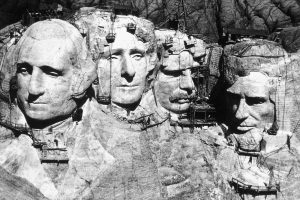
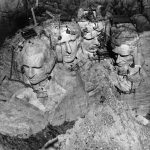 appeared in works of fiction, as well as being discussed or depicted in other popular works. It has also been featured a number of movies. It attracts over two million visitors annually. It’s amazing to me that what started out to be a tourist attraction, quickly became a must see place for every patriotic American. My husband and I love to go to the Black Hills, and with the close proximity to our Casper, Wyoming home, we take a week every summer to go and enjoy the beauty and patriotism that now resides there.
appeared in works of fiction, as well as being discussed or depicted in other popular works. It has also been featured a number of movies. It attracts over two million visitors annually. It’s amazing to me that what started out to be a tourist attraction, quickly became a must see place for every patriotic American. My husband and I love to go to the Black Hills, and with the close proximity to our Casper, Wyoming home, we take a week every summer to go and enjoy the beauty and patriotism that now resides there.
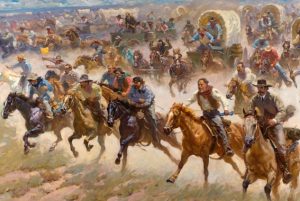 As Americans began to expand to the West, new territories had to be opened for settlement. Of course, this was not always met with approval from the Indian nations who were living there at the time. Nevertheless, the settling of this nation would not be stopped, and while it was handled wrong in many ways, it was inevitable. Nearly two million acres of land in Oklahoma Territory had been preciously deemed unsuitable for white settlement, and so were given to the Native Americans who had been previously removed from their traditional lands to allow for white settlement. The relocations began in 1817. By the 1880s, Indian Territory was home to a variety of tribes, including the Chickasaw, Choctaw, Cherokee, Creek, Cheyenne, Comanche, and Apache.
As Americans began to expand to the West, new territories had to be opened for settlement. Of course, this was not always met with approval from the Indian nations who were living there at the time. Nevertheless, the settling of this nation would not be stopped, and while it was handled wrong in many ways, it was inevitable. Nearly two million acres of land in Oklahoma Territory had been preciously deemed unsuitable for white settlement, and so were given to the Native Americans who had been previously removed from their traditional lands to allow for white settlement. The relocations began in 1817. By the 1880s, Indian Territory was home to a variety of tribes, including the Chickasaw, Choctaw, Cherokee, Creek, Cheyenne, Comanche, and Apache.
By the 1890s, with the improvements in agricultural and ranching techniques led some white Americans to realize that the Indian Territory land could be valuable, so they began to pressure the United States government to allow white settlement in the region. In 1889, President Benjamin Harrison agreed, making the first of a long series of authorizations that eventually removed most of Indian Territory from Indian control. To begin the process of white settlement, President Harrison chose to open a 1.9 million acre section of Indian Territory that the government had never assigned to any specific tribe. I suppose it was a way to ease into it without taking land from any specific tribe…initially anyway. However, subsequent openings of sections that 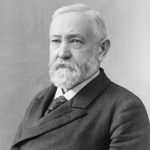 were designated to specific tribes were achieved primarily through the Dawes Severalty Act of 1887, which allowed whites to settle large swaths of land that had previously been designated to specific Indian tribes.
were designated to specific tribes were achieved primarily through the Dawes Severalty Act of 1887, which allowed whites to settle large swaths of land that had previously been designated to specific Indian tribes.
On March 3, 1889, Harrison announced the government would open the 1.9 million-acre tract of Indian Territory for settlement precisely at noon on April 22, 1889. Anyone could join the race for the land, but no one was supposed to jump the gun. With only seven weeks to prepare, the land-hungry Americans quickly began to gather around the borders of the irregular rectangle of territory. They were referred to as “Boomers,” and by the appointed day more than 50,000 hopefuls were living in tent cities on all four sides of the territory. At precisely high noon, thousands of would-be settlers make a mad dash into the newly opened Oklahoma Territory to claim cheap land. I can only imagine the chaos. The events that day at Fort Reno on the western border were typical of the entire process. At 11:50am, soldiers called for everyone to form a line. When the hands of the clock reached noon, the cannon of the fort boomed, and the soldiers signaled the settlers to start. With the crack of hundreds of whips, thousands of Boomers streamed into the territory in wagons, on horseback, and on foot. All told, from 50,000 to 60,000 settlers entered the territory that day. By nightfall, they had staked thousands of claims either on town lots or quarter section farm plots. Towns like Norman, Oklahoma City, Kingfisher, and Guthrie sprang into being almost overnight.
 An extraordinary display of both the pioneer spirit and the American lust for land, the first Oklahoma land rush was also plagued by greed and fraud. Cases involving “Sooners,” who were people who had entered the territory before the legal date and time overloaded courts for years to come. I’m sure that the Indians weren’t pleased either, and I would imagine that there was periodic trouble over the whole process too. The government attempted to improve the operations of subsequent runs by adding more controls, finally adopting a lottery system to designate claims. By 1905, white Americans owned most of the land in Indian Territory. Two years later, the area once known as Indian Territory entered the Union as a part of the new state of Oklahoma.
An extraordinary display of both the pioneer spirit and the American lust for land, the first Oklahoma land rush was also plagued by greed and fraud. Cases involving “Sooners,” who were people who had entered the territory before the legal date and time overloaded courts for years to come. I’m sure that the Indians weren’t pleased either, and I would imagine that there was periodic trouble over the whole process too. The government attempted to improve the operations of subsequent runs by adding more controls, finally adopting a lottery system to designate claims. By 1905, white Americans owned most of the land in Indian Territory. Two years later, the area once known as Indian Territory entered the Union as a part of the new state of Oklahoma.
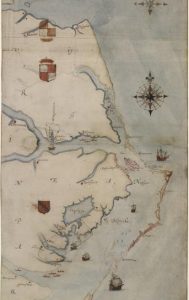 When I think of a lost people, I think of a tribe in Africa or somewhere very isolated, but I never think of someplace in America! Nevertheless, it happened right here in America. Of course, it was a long…long time ago. It was long before people could easily track someone down. The year was 1587, the day was July 22. That was the day when the new colony arrived in Roanoke, North Carolina, which was colonial Virginia. On August 18, 1587, the first English baby to be born in the Americas, Virginia Dare was born. The group had been dispatched by Sir Walter Raleigh, and was led by John White, who by the way, was Virginia Dare’s grandfather. Upon their arrival, they found nothing of the English garrison that had gone ahead, except one skeleton. The people really didn’t want to stay there after that, but the fleet commander, Simon Fernandez would not let them return to the ship, and the ships sailed with the promise of new supplies to come.
When I think of a lost people, I think of a tribe in Africa or somewhere very isolated, but I never think of someplace in America! Nevertheless, it happened right here in America. Of course, it was a long…long time ago. It was long before people could easily track someone down. The year was 1587, the day was July 22. That was the day when the new colony arrived in Roanoke, North Carolina, which was colonial Virginia. On August 18, 1587, the first English baby to be born in the Americas, Virginia Dare was born. The group had been dispatched by Sir Walter Raleigh, and was led by John White, who by the way, was Virginia Dare’s grandfather. Upon their arrival, they found nothing of the English garrison that had gone ahead, except one skeleton. The people really didn’t want to stay there after that, but the fleet commander, Simon Fernandez would not let them return to the ship, and the ships sailed with the promise of new supplies to come.
John White was not allowed to stay, and so returned to England on August 27, 1587…vowing to return in three months time. That was about the time of the Spanish Armada attack in 1588, which delayed White’s return to Roanoke. White tried desperately to return to the little colony for the next three years. When he was finally able to get there, he came rushing onshore, only to find that the colony was gone. 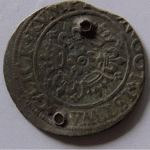
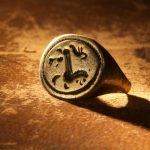 Among those missing was the little girl, Virginia Dare, White’s granddaughter. They had arrived on what would have been her third birthday…August 15. Whites return was delayed because of the Anglo-Spanish war, and the Spanish ships that robbed the expedition of the supplies they were taking over to the colonists. It is suspected that the colony disappeared during that war, but there is no clear clarification as to where they went or who took them.
Among those missing was the little girl, Virginia Dare, White’s granddaughter. They had arrived on what would have been her third birthday…August 15. Whites return was delayed because of the Anglo-Spanish war, and the Spanish ships that robbed the expedition of the supplies they were taking over to the colonists. It is suspected that the colony disappeared during that war, but there is no clear clarification as to where they went or who took them.
There has been much speculation as to the fate of the Roanoke Lost Colony, but the sure fate of the settlers left behind is unknown and the colony is known as the “Lost Colony” of Roanoke to this day. Over the years numerous attempts have been made to find the Lost Colony, including the Lost Colony DNA Project started in 2005. Recent investigations speculate that the Lost Colony relocated to where the Chowan River meets the Albemarle Sound in present day Bertie County, North Carolina. Nevertheless, recent discoveries found  European objects in the Hatteras Island area, including a sword hilt, broken English bowls, and a fragment of a slate writing tablet still inscribed with a letter. These could point to the presence of the colonists on Hatteras Island, some 50 miles southeast of their settlement on Roanoke Island. There were also some found at a site on the mainland 50 miles to the northwest. Some people have thought that the Native Americans took the people or at least assimilated them into their tribe, because there are in some of that modern day tribe of people with strangely gray eyes. I suppose we will never really know the reality of what happened, but I would rather think that the Native Americans took them in, than to think that they were killed.
European objects in the Hatteras Island area, including a sword hilt, broken English bowls, and a fragment of a slate writing tablet still inscribed with a letter. These could point to the presence of the colonists on Hatteras Island, some 50 miles southeast of their settlement on Roanoke Island. There were also some found at a site on the mainland 50 miles to the northwest. Some people have thought that the Native Americans took the people or at least assimilated them into their tribe, because there are in some of that modern day tribe of people with strangely gray eyes. I suppose we will never really know the reality of what happened, but I would rather think that the Native Americans took them in, than to think that they were killed.
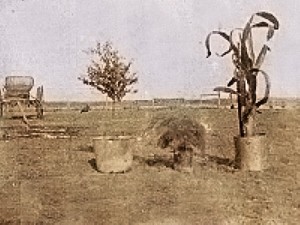
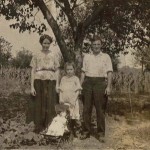 I have often wondered what our nation looked like before the Native Americans altered the landscape with the only way they really had of clearing the land…fire. When the summer grasslands would grow so tall that it made travel by horse or on foot troublesome, the Indians just started a fire to clear the area. Since there was nothing standing in the way of the fire, it ran until it came to a river or some other kind of obstacle, such as an area void of vegetation, and then it simply burned itself out. Of course, rain or snow would have the same effect too. I wonder, like many other people do, if prior to that practice, there were forests where we now have plains.
I have often wondered what our nation looked like before the Native Americans altered the landscape with the only way they really had of clearing the land…fire. When the summer grasslands would grow so tall that it made travel by horse or on foot troublesome, the Indians just started a fire to clear the area. Since there was nothing standing in the way of the fire, it ran until it came to a river or some other kind of obstacle, such as an area void of vegetation, and then it simply burned itself out. Of course, rain or snow would have the same effect too. I wonder, like many other people do, if prior to that practice, there were forests where we now have plains.
Of course, the White Man, has come a long way in trying to bring trees back into our nation, but there are still many places that are just wide open spaces filled with prairie grass, sagebrush, and cactus. When my grandparents, Anna and Allen Spencer decided to move to Texas to check out the booming oil industry, they found a land that seemed to run for hundreds of miles, with little to see, but wide open spaces. Like many people, they longed for trees, and other vegetation to give a different view to the land they found themselves living on. Having lived on five acres myself for a number of years before moving into town, I can certainly understand wanting trees. That didn’t make it easy to grow any of them up to much size, however. I suppose it 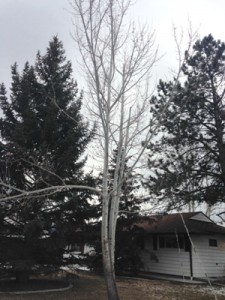 might have been easier in Texas, due to their warmer climate.
might have been easier in Texas, due to their warmer climate.
I understand the need Native Americans had to clear the land, and the lack of sufficient tools to do so, when it was necessary. Nevertheless, I wish they had not burned down the trees…or the prairies, because that stopped the young trees from growing, and lets face it…we need trees for shade, and the very air we breathe. These days, with all the necessary tools, from lawnmowers to farm equipment, there is no need to burn down the prairie grass to keep it from getting so deep, so clearing the land is a much smoother project. The older I get, the more I find myself wanting trees around me, and while it is still hard to get them up to some size, due mainly to the deer that roam freely inside the city limits of Casper, Wyoming, I do have some volunteer Silver Birch trees that have moved themselves from the neighbors tree into our yard.
We were so excited when the first tree started coming up, but our neighbor, Bill thought we would be upset about the little trespassing trees, and so he cut the down…until we told him that we wanted them. Then he left them alone so we could decide to let them grow or not. That first tree is now taller that our house, and we have several in the back yard too. Before these trees began growing, we had three cedar bushes in our front yard, one that was let grow to the size of a rather ugly tree. Finally, the day came that we got one of those little trespassing trees to come up in the right place. While we liked the bushes, that ugly Cedar tree needed to go. Then that tree got to an area where it could work for what we wanted. This past summer, it had grown to the 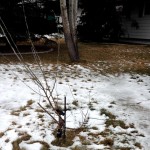
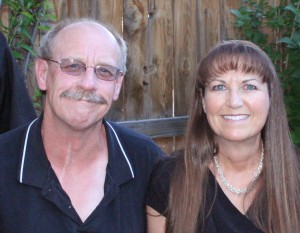 point of being about my height. Life was good. We cut down that ugly Cedar bush that had been pretending to be a tree, and watch with excitement as our new little trespassing tree grew and flourished…and then it happened. The deer that I love to have in our yard, because they are so beautiful…decided that our little tree was just the right size for lunch. It’s hard to say if it will come back in the spring, but if not, there will be another little trespasser to grow in its place…life is still good!!!
point of being about my height. Life was good. We cut down that ugly Cedar bush that had been pretending to be a tree, and watch with excitement as our new little trespassing tree grew and flourished…and then it happened. The deer that I love to have in our yard, because they are so beautiful…decided that our little tree was just the right size for lunch. It’s hard to say if it will come back in the spring, but if not, there will be another little trespasser to grow in its place…life is still good!!!

